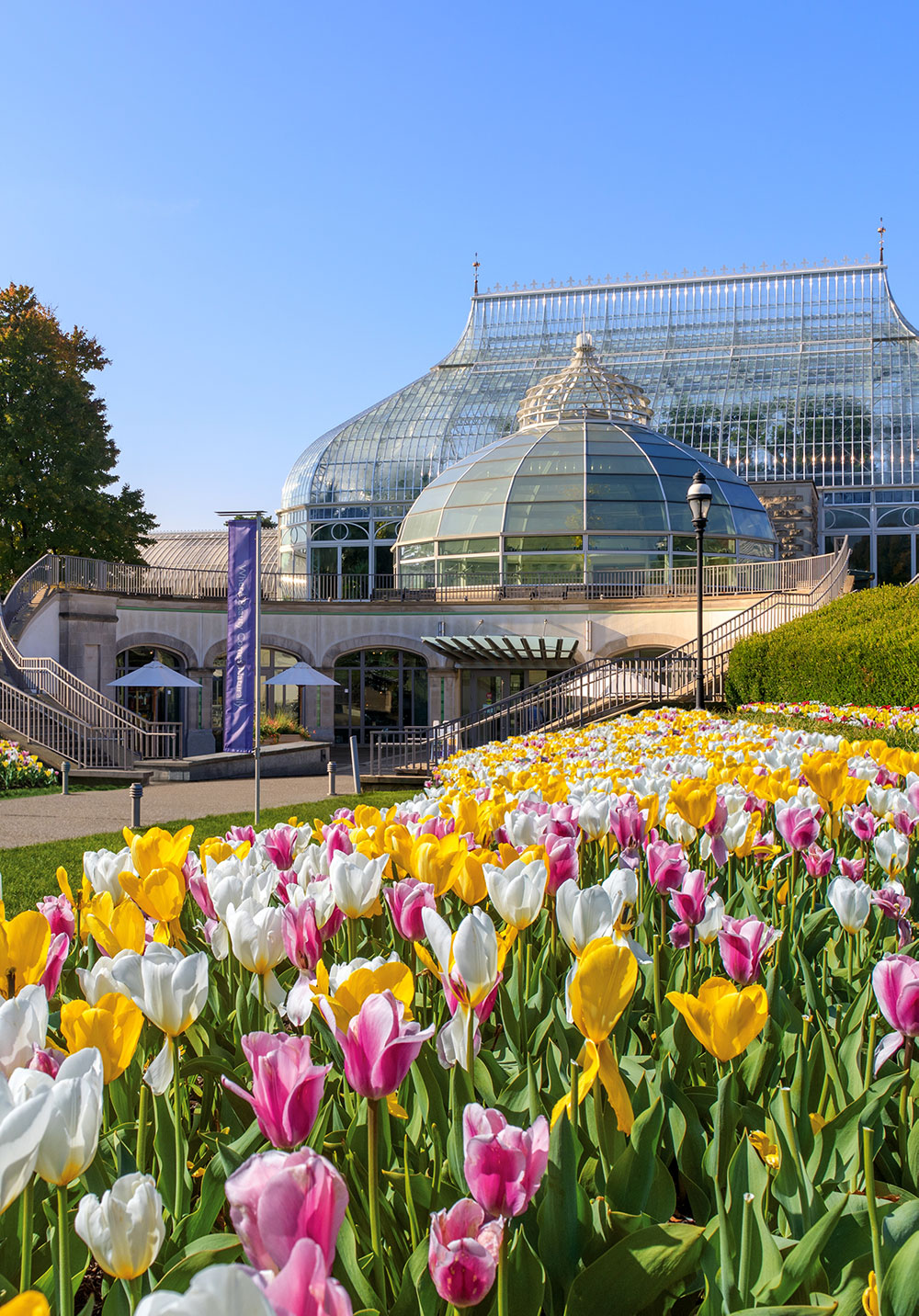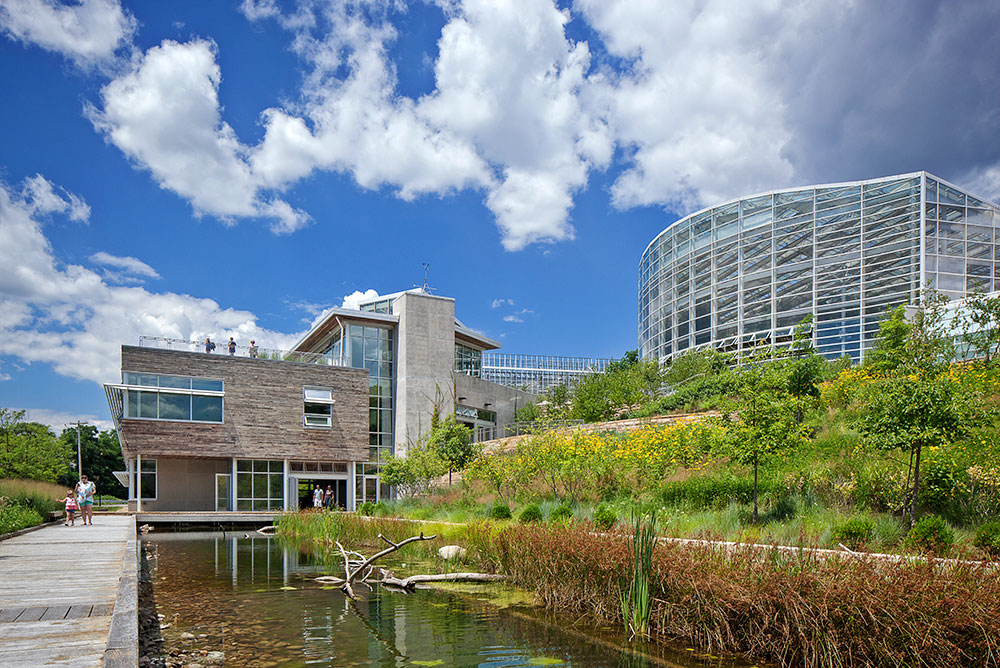Greener Greens
"We did all of this without rocket science," says Richard Piacentini '84 MS, of turning Phipps Conservatory into a model of green building. "It was all done with off-the-shelf technology. That's what we need to show people, that it's possible to do this."
By Amy Sutherland
Photos by Paul G. Wiegman, Denmarsh Photography, Inc., and David Aschkenas
M
ost people visit Pittsburgh's Phipps Conservatory to immerse themselves in nature. They wander in the butterfly forest and amble through the lush fern room. But some come solely to contemplate the manmade world. Amid the thousands of plants is an even rarer sight than the conservatory's oversized slipper orchids: three of the world's greenest buildings all in one location.
The Conservatory's Center for Sustainable Landscapes is the only structure in the world to have been awarded all the top certifications for green architecture. The Nature Lab, a modular classroom, was constructed from nontoxic materials and is mostly illuminated by daylight to reduce electricity use. And a windowless cinder block building on a badly polluted site was revamped into a model of sustainability with geothermal wells that pull energy from the earth and a manmade lagoon to catch rainwater.
Most people visit Pittsburgh's Phipps Conservatory to immerse themselves in nature. They wander in the butterfly forest and amble through the lush fern room. But some come solely to contemplate the manmade world. Amid the thousands of plants is an even rarer sight than the conservatory's oversized slipper orchids: three of the world's greenest buildings all in one location.
The Conservatory's Center for Sustainable Landscapes is the only structure in the world to have been awarded all the top certifications for green architecture. The Nature Lab, a modular classroom, was constructed from nontoxic materials and is mostly illuminated by daylight to reduce electricity use. And a windowless cinder block building on a badly polluted site was revamped into a model of sustainability with geothermal wells that pull energy from the earth and a manmade lagoon to catch rainwater.
"I remember walking around a corner and seeing the 1893 conservatory, and I fell in love."
"We did all of this without rocket science," says Phipps president and CEO Richard Piacentini '84 MS. "It was all done with off-the-shelf technology. That's what we need to show people, that it's possible to do this."

A botanical garden, between its vast energy-guzzling greenhouses and its contrived vision of nature made from exotic plants from far-flung corners of the globe, isn't a likely leader on sustainability. Grand conservatories were the brainchild of the Victorians, who were certain that they could conquer the plant and animal kingdoms, Piacentini says. "When Phipps opened in 1893 people thought there were no limits to the amount of energy we could use or pollution we could produce."
By the time Piacentini arrived at Phipps in 1994 there was plenty of evidence to the contrary. But saving the environment wasn't what weighed heaviest on Piacentini's mind. What kept him up at night was how to shore up Phipps. He inherited an institution well past its glory days. The greenhouses were falling apart. The gift shop was teeny, there was no food service, and often there wasn't that much on exhibit to see. "I once heard a visitor ask for his money back," he recalls.
A Long Island native, Piacentini discovered his love of plants early on, but he found his career late, after a false start in pharmacy. Working in that field in Washington, D.C., he came to realize what he liked most was growing Japanese bonsai and visiting the National Arboretum. On one such visit he surprised himself by asking a staff botanist there what degrees he needed to run a place like the Arboretum.
Piacentini started with an MBA from Virginia Commonwealth, then brought his bonsai collection north for a doctoral program in botany from UConn, drawn by the work of Distinguished Professor Gregory Anderson. He worked in Anderson's lab, helped with the horticultural department's dwarf conifer collection, and to get practical experience drove to Long Island two days a week to volunteer at the Planting Fields Arboretum. He also worked as a pharmacist on the weekend. There was no time for Husky games. "Afraid not," he says.

The Ph.D. became a masters when Piacentini got an offer he couldn't refuse and headed west to become director of the Rhododendron Species Foundation and Botanical Garden in the Seattle area. He later moved to Michigan to run the sprawling Leila Arboretum in Battle Creek. He wasn't that interested when a recruiter for Phipps Conservatory called him about the director's job there. But why not just go see the place? "I remember walking around a corner and seeing the 1893 conservatory, and I fell in love. Then I wanted the job."
Piacentini and his board embarked on an ambitious plan to expand the Conservatory, starting with the visitors center. They began talking to design teams, one of which happened to include Bill McDonough, the leading green architect in the country then. He urged Piacentini and his board to make their buildings sustainable. Going green hadn't even occurred to them, Piacentini says, but "we care about the environment, so why shouldn't our buildings reflect that?"
Starting with the visitors center, which opened in 2005, Phipps began erecting some of the greenest structures in any U.S. botanical garden. The Tropical Forest Conservatory, as tall as a six-story building, is one of the most energy-efficient structures of its kind in the world. Three Phipps buildings have earned the top LEED certification, the country's most recognized seal of approval for green architecture. Two have also met Living Building Challenge and Petal Certifications, the most rigorous rating that, unlike LEED, monitors actual energy and water use.
Piacentini thought, Why stop with the buildings? Phipps eliminated plastic silverware, bottled water and soda, and junk food in its cafe and began composting every speck of food waste. It also searched for ways to have an effect beyond its gates, from developing research projects with area academics to forming an in-house design group that can advise commercial clients. The Conservatory began to offer a free one-year membership to anyone who switched their home electricity to renewable energy (more than 5,000 households have to date). In his own home, Piacentini installed solar panels and geothermal heating.
None of this surprises his former professor: "Not only was — is — Richard one of the most pleasant persons to work with, but he was also imbued with the vision, creativity, motivation, and leadership to make such a positive con- tribution to our world," says Anderson.
These days the Phipps CEO is working with execs at other botanical gardens around the country to create a joint statement on how they will address climate change, such as agreeing to make their buildings use zero energy.
"Something aggressive like that to show we aren't going to be followers in our community," says Piacentini. "We are going to be leaders."

"We care about the environment, so why shouldn't our buildings reflect that?" asks Piacentini '84 MS at Phipps's Center for Sustainable Landscapes. The administration building generates more energy than it uses and recycles all its storm and sanitary water. It has been awarded the top four green architecture certifications — the only structure in the world with that distinction.
Pittsburgh residents who switch their home electricity to renewable energy receive free one-year memberships to the Conservatory and need never miss an orchid bloom.

To Richard Piacentini: Richard – Saw this story and read about your sold-out “Waste Not Dinner” event Friday night and ongoing “Healthy Food” program. I’ve passed all of this along to UConn Political Science/Human Rights Prof. Shareen Hertel, who is lecturing at University of Pittsburgh this week. She is coming over to see what you are doing. As you know, environmental sustainability is a Human Right. Also passing this along to Maria Chrysochoou, for all of the environmental engineers in her department (Civil & Environmental Engineering).
Congratulations on all of your accomplishments! Cheers!